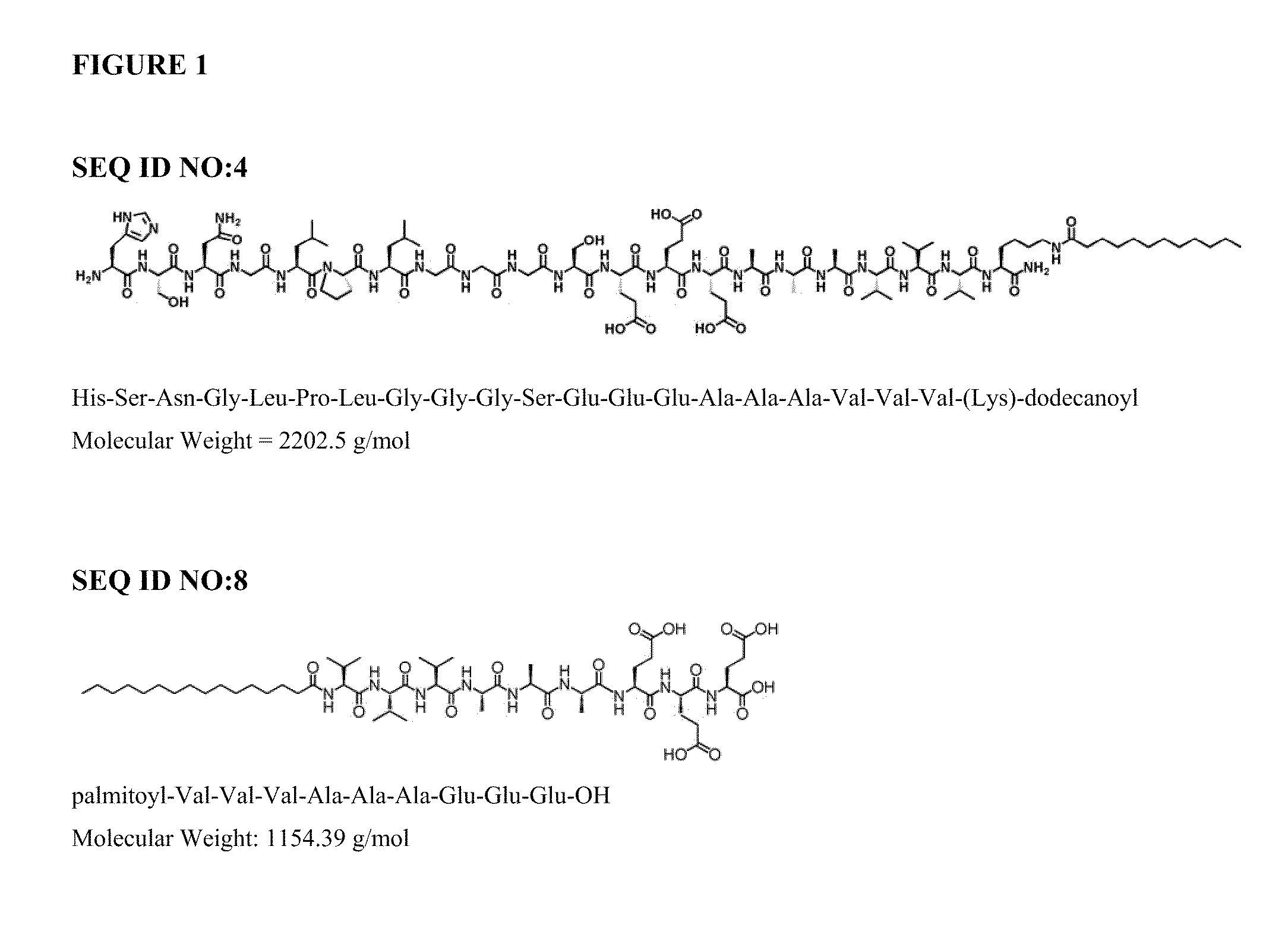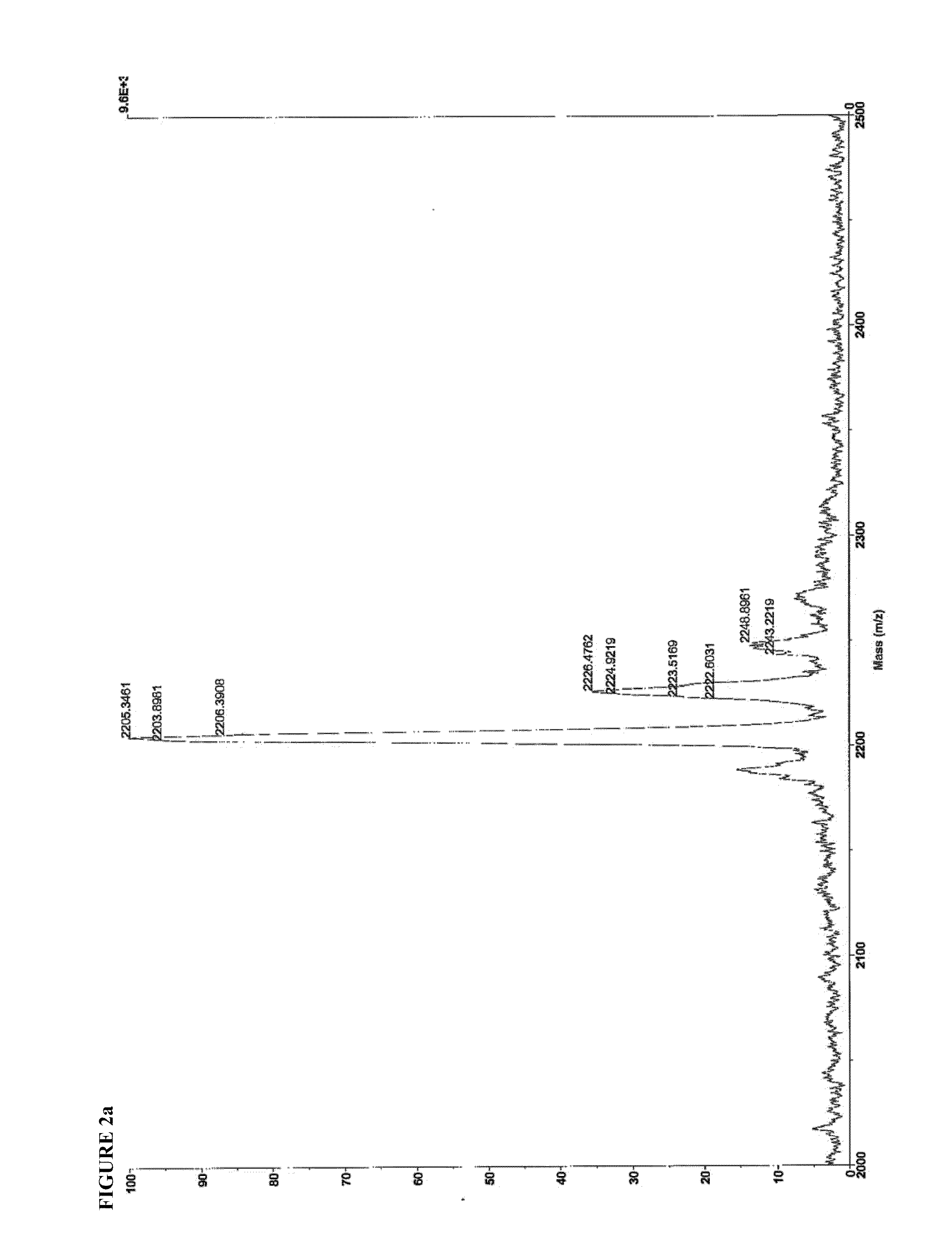Novel peptide-based scaffolds for cartilage regeneration and methods for their use
- Summary
- Abstract
- Description
- Claims
- Application Information
AI Technical Summary
Benefits of technology
Problems solved by technology
Method used
Image
Examples
example 1
Automated Synthesis and Purification of Peptide Amphiphiles Containing the TGF-Binding Segment HSNGLPL (SEQ ID NO:1), Including SEQ ID NO:4
[0115]1.1 Reagents:
[0116]The following reagents, or equivalents, were used as received: HBTU (2-(1H-Benzotriazol-1-yl)-1,1,3,3-tetramethyluronium hexafluorophosphate), piperidine, DIEA (n,n,-diisopropylethlamine), DMF (n,n-dimethylformamide), DCM (dichloromethane), TFA (trifluoroacetic acid), TIS (triisopropylsilane). All water was purified by reverse osmosis and filtered using a Millipore™ system to a resistivity of 18.2 Mohm-cm. 9-Fluorenylmethoxycarbonyl (Fmoc) protected amino acids and orthogonally protected Fmoc-Lys(Mtt)-OH were purchased from EMD Biosciences (La Jolla, Calif.). Peptides were synthesized on Rink amide resin (loading 0.6-0.75 mmole / g).
[0117]1.2 Peptide Synthesis:
[0118]Peptides were synthesized via solid-phase methodology on an automated peptide synthesizer (CS Bio Co. model 136XT), using a 250 mL glass reaction vessel which w...
example 2
Synthesis of Filler Peptide Amphiphile C16H31O-VVVAAAEEE (SEQ. ID NO:8)
[0127]The filler PA was synthesized via automated solid phase peptide synthesis as described above, except a pre-loaded glutamic acid Wang resin was used. Additional amino acids were coupled as described, proceeding from C- to N-terminus. After coupling of the N-terminal valine, the peptide was capped with a palmitoyl moiety, which was accomplished as described in Example 1.2 by substituting palmitic acid for dodecanoic acid. Peptide cleavage from the resin, HPLC purification, aseptic filtration and lyophilization were performed as described in Examples 1.3-1.6.
example 3
Chemical Characterization of Peptide Amphiphiles
[0128]Peptide amphiphiles were characterized as to identity and purity using mass spectroscopy (MS), high performance liquid chromatography (HPLC), and amino acid analysis (AAA), as described below.
[0129]3.1 Mass Spectroscopy
[0130]Identity of SEQ ID NO:4 and SEQ ID NO:8 were confirmed by matrix-assisted laser desorption-ionization time-of-flight mass spectroscopy (MALDI-TOF MS), using a Voyager DE-PRO instrument operating in positive ion mode, with CHCA matrix. 1 uL of a 1 mg / mL solution was spotted onto the MALDI plate. The mass spectra are shown in FIG. 2.
SEQ ID. NO: 4Expected m / z = 2201.22Found m / z =2203.90[M + H+]2226.48[M − H + Na+]2243.22[M − H + K+]2248.90[M − H + 2Na+]SEQ ID. NO: 8Expected m / z = 1153.68Found m / z =1176.78[M − H + Na+]1198.91[M − H + 2Na+]1198.92[M − H + 3Na+]1076.23Valine deletion
[0131]3.2 Analytical HPLC
[0132]Analytical, reverse-phase HPLC was performed to determine the peptide purity of the molecules synthesiz...
PUM
| Property | Measurement | Unit |
|---|---|---|
| Time | aaaaa | aaaaa |
| Time | aaaaa | aaaaa |
| Time | aaaaa | aaaaa |
Abstract
Description
Claims
Application Information
 Login to View More
Login to View More - R&D
- Intellectual Property
- Life Sciences
- Materials
- Tech Scout
- Unparalleled Data Quality
- Higher Quality Content
- 60% Fewer Hallucinations
Browse by: Latest US Patents, China's latest patents, Technical Efficacy Thesaurus, Application Domain, Technology Topic, Popular Technical Reports.
© 2025 PatSnap. All rights reserved.Legal|Privacy policy|Modern Slavery Act Transparency Statement|Sitemap|About US| Contact US: help@patsnap.com



